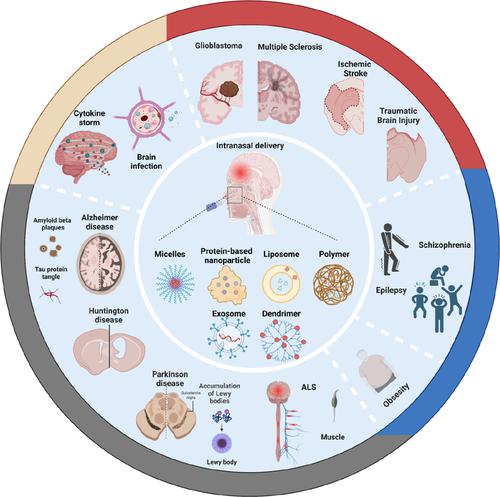当前位置:
X-MOL 学术
›
WIREs Nanomed. Nanobiotechnol.
›
论文详情
Our official English website, www.x-mol.net, welcomes your feedback! (Note: you will need to create a separate account there.)
Nose-to-brain delivery of nanotherapeutics: Transport mechanisms and applications
WIREs Nanomedicine and Nanobiotechnology ( IF 8.6 ) Pub Date : 2024-04-01 , DOI: 10.1002/wnan.1956 Kunyao Xu 1, 2 , Suqin Duan 1 , Wenjing Wang 3, 4 , Qiuhong Ouyang 5 , Feng Qin 5 , Peilin Guo 3, 4 , Jinghan Hou 1 , Zhanlong He 1 , Wei Wei 3, 4 , Meng Qin 2, 5
WIREs Nanomedicine and Nanobiotechnology ( IF 8.6 ) Pub Date : 2024-04-01 , DOI: 10.1002/wnan.1956 Kunyao Xu 1, 2 , Suqin Duan 1 , Wenjing Wang 3, 4 , Qiuhong Ouyang 5 , Feng Qin 5 , Peilin Guo 3, 4 , Jinghan Hou 1 , Zhanlong He 1 , Wei Wei 3, 4 , Meng Qin 2, 5
Affiliation

|
The blood–brain barrier presents a key limitation to the administration of therapeutic molecules for the treatment of brain disease. While drugs administered orally or intravenously must cross this barrier to reach brain targets, the unique anatomical structure of the olfactory system provides a route to deliver drugs directly to the brain. Entering the brain via receptor, carrier, and adsorption-mediated transcytosis in the nasal olfactory and trigeminal regions has the potential to increase drug delivery. In this review, we introduce the physiological and anatomical structures of the nasal cavity, and summarize the possible modes of transport and the relevant receptors and carriers in the nose-to-brain pathway. Additionally, we provide examples of nanotherapeutics developed for intranasal drug delivery to the brain. Further development of nanoparticles that can be applied to intranasal delivery systems promises to improve drug efficacy and reduce drug resistance and adverse effects by increasing molecular access to the brain.
中文翻译:

纳米治疗药物从鼻子到大脑的输送:输送机制和应用
血脑屏障是治疗脑疾病的治疗分子给药的一个关键限制。虽然口服或静脉注射的药物必须穿过这一屏障才能到达大脑目标,但嗅觉系统独特的解剖结构提供了将药物直接输送到大脑的途径。通过鼻嗅区和三叉神经区的受体、载体和吸附介导的转胞吞作用进入大脑,有可能增加药物输送。在这篇综述中,我们介绍了鼻腔的生理和解剖结构,并总结了鼻-脑通路中可能的运输方式以及相关的受体和载体。此外,我们还提供了为鼻内药物输送至大脑而开发的纳米疗法的示例。可应用于鼻内递送系统的纳米颗粒的进一步开发有望通过增加分子进入大脑的途径来提高药物疗效并减少耐药性和不良反应。
更新日期:2024-04-02
中文翻译:

纳米治疗药物从鼻子到大脑的输送:输送机制和应用
血脑屏障是治疗脑疾病的治疗分子给药的一个关键限制。虽然口服或静脉注射的药物必须穿过这一屏障才能到达大脑目标,但嗅觉系统独特的解剖结构提供了将药物直接输送到大脑的途径。通过鼻嗅区和三叉神经区的受体、载体和吸附介导的转胞吞作用进入大脑,有可能增加药物输送。在这篇综述中,我们介绍了鼻腔的生理和解剖结构,并总结了鼻-脑通路中可能的运输方式以及相关的受体和载体。此外,我们还提供了为鼻内药物输送至大脑而开发的纳米疗法的示例。可应用于鼻内递送系统的纳米颗粒的进一步开发有望通过增加分子进入大脑的途径来提高药物疗效并减少耐药性和不良反应。



























 京公网安备 11010802027423号
京公网安备 11010802027423号